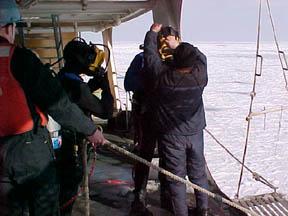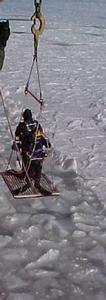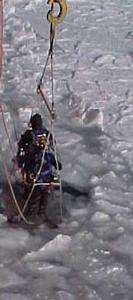28 March, 2001
Tidbit of History
The Arctic Circle is the parallel of latitude at about 66-33N, 23.5 degrees
south of the North Pole. It marks the southern limit of the north Frigid
Zone. This area is the northern most point at which the sun is visible
during the winter solstice. It is also the southern most point at which the
midnight sun can be seen during northern mid-summer.
Science Observations
The big news of the day was the diving that took place off the side of the
ship. Approximately 5 p.m. 1 Navy diver, who is TAD (temporary active duty)
and 2 divers that are dive certified through the Navy Dive school prepared
to go underwater off the side of the ship. The water temperature is
approximately 30 degrees (a big difference from body temperature). Two of
the main purposes of the dive were to collect algae samples from under the
ice. The dry suits appeared to be thick and lined with a fleece type
material. A fluorescent colored knife was attached to each of their legs as
well as other pieces of equipment on their legs and back. Parcticularly
interesting were the peanut butter jar with a lid and the butterfly net!
The peanut butter jar would be used to collect a water sample and the
butterfly net would be used to collect an ice sample. Two air tanks and a
long cable were connected to each diver. They each sat on the deck as
complete and thorough safety checks were conducted. One diver prepared to
go underwater with a rather large video camera to film the entire event.
A hole was made in the ice for the divers to enter. Once all points were
checked, a platform was lowered down from a higher area on the ship to
become level with the deck. The divers were helped up from their seated
position and fins were attached to their feet. There were no exposed areas
on their bodies! The divers moved to a standing position holding onto
handles located on the side of the platform. Once steady, the divers were
gently lowered down to the ice. They remained standing on the ice briefly
before being lowered a little further. This provided an opportunity for
them to become acclimated to the water. Within a few seconds the divers
went underwater. They remained underwater for approximately 30 minutes. A
second group of divers completed the same procedure upon the first group's
return.
Once the divers returned, the water and ice samples were received in the
Science lab. Mark Geesey, from the University of Charleston, ran a
chlorophyll reading. He was pleased with results. I observed the filter
paper and it was very green! This was a neat opportunity!
Daily Update
The moon was a beautiful pink crescent shape last night. The stars were
shining brightly. We did not see the Northern Lights.
We had a rude awakening this morning with the General Alarm right after
Reveille. Smoke was reported in the incinerator room. The bridge did an
excellent job in ensuring our highest state of safety by setting "General
Emergency". Folks were rolling out of bed and moving toward their muster
points when the announcement was piped that luckily the smoke was actually
was. Safety is of utmost importance on the ship!
Today the air temperature was approximately 18. It was much easier to work
outside and the water in the CTD grab flowed easily without becoming iced.
We completed 3 science stations yesterday and are approaching the end. We
are going to revisit some of the areas that were previously worked for
further study. One station VNG 3.5 will be revisited for the third time.
Three times is a charm hopefully. We have not been able to collect anything
at this location. The ice has been described as applesauce ice. The ship
cuts into it creating a hole but the hole quickly refills with ice
preventing the equipment from being launched off the side of the ship.
Both helicopters were operational today for Marine Mammal flights. Animals
of interest include a few seals, a couple of bowheads and a pod of
approximately 20 belugas. This is a rather small pod as these whales
usually swim in pods of 100.

<> Divers early preparation.

<> Lots of preparations occur prior to diving.

<> Standing on the platform preparing for the icy cold water.

<> Lowering down to the water.

<> Standing on the ice prior to going under water!
Contact the TEA in the field at
.
If you cannot connect through your browser, copy the
TEA's e-mail address in the "To:" line of
your favorite e-mail package.
|
